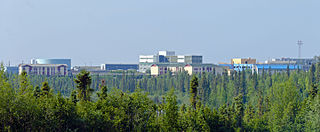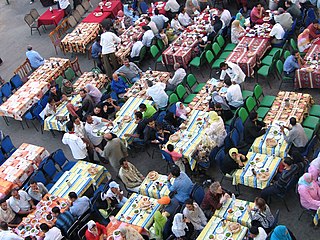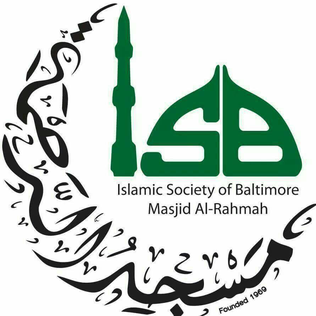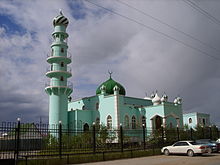The Five Pillars of Islam are fundamental practices in Islam, considered to be obligatory acts of worship for all Muslims. They are summarized in the hadith of Gabriel. The Sunni and Shia agree on the basic details of the performance and practice of these acts, but the Shia do not refer to them by the same name. They are: Muslim creed, prayer, charity to the poor, fasting in the month of Ramadan, and the pilgrimage to Mecca for those who are able.

The Northwest Territories is a federal territory of Canada. At a land area of approximately 1,144,000 km2 (442,000 sq mi) and a 2016 census population of 41,790, it is the second-largest and the most populous of the three territories in Northern Canada. Its estimated population as of 2023 is 45,668. Yellowknife is the capital, most populous community, and only city in the territory; its population was 19,569 as of the 2016 census. It became the territorial capital in 1967, following recommendations by the Carrothers Commission.

Ramadan is the ninth month of the Islamic calendar, observed by Muslims worldwide as a month of fasting (sawm), prayer (salah), reflection, and community. A commemoration of Muhammad's first revelation, the annual observance of Ramadan is regarded as one of the Five Pillars of Islam and lasts twenty-nine to thirty days, from one sighting of the crescent moon to the next.

Eid al-Fitr is the earlier of the two official holidays celebrated within Islam. Eid al-Fitr is celebrated by Muslims worldwide because it marks the end of the month-long dawn-to-sunset fasting of Ramadan. Eid al-Fitr falls on the first day of Shawwal in the Islamic calendar; this does not always fall on the same Gregorian day, as the start of any lunar Hijri month varies based on when the new moon is sighted by local religious authorities. The holiday is known under various other names in different languages and countries around the world. The day is also called "Lesser Eid", or simply Eid.

Inuvik is the only town in the Inuvik Region, and the third largest community in Canada's Northwest Territories. Located in what is sometimes called the Beaufort Delta Region, it serves as its administrative and service centre and is home to federal, territorial, and Indigenous government offices, along with the regional hospital and airport.

Kitikmeot Region is an administrative region of Nunavut, Canada. It consists of the southern and eastern parts of Victoria Island with the adjacent part of the mainland as far as the Boothia Peninsula, together with King William Island and the southern portion of Prince of Wales Island. The regional centre is Cambridge Bay.

Area code 867 is the area code in the North American Numbering Plan (NANP) for the three Canadian territories, all of which are in Northern Canada. The area code was created on October 21, 1997, by combining regions that were previously served with area code 403 and area code 819 in one numbering plan area (NPA). As the least populated NPA in mainland North America, serving about 130,000 people, it is geographically the largest, at 3,921,739 km2 (1,514,192 sq mi), with Alaska (907) a distant second.

The Arctic Winter Games are a biennial multi-sport and indigenous cultural event involving circumpolar peoples residing in communities or countries bordering the Arctic Ocean.
In Islam, fasting is the practice of abstaining, usually from food, drink, sexual activity and anything which substitutes food and drink. During the holy month of Ramadan, sawm is observed between dawn and sunset when the adhan of the Maghrib prayer is sounded. Ramadan is the ninth month of the Muslim lunar calendar and fasting is a requirement for Muslims as it is the fourth of the five pillars of Islam.

Iftar is the fast-breaking evening meal of Muslims in Ramadan at the time of adhan of the Maghrib prayer.

CBC North is the Canadian Broadcasting Corporation's radio and television service for the Northwest Territories, Nunavut, and Yukon of Northern Canada as well as Eeyou Istchee and Nunavik in the Nord-du-Québec region of Quebec.
During the entire month of Ramadan, Muslims are obligated to fast, every day from dawn to sunset. Fasting requires the abstinence from sex, food, drinking, and smoking. Fasting the month of Ramadān was made obligatory (wājib) during the month of Sha'ban, in the second year after the Muslims migrated from Mecca to Medina. Fasting for the month of Ramadan is one of the Five Pillars of Islam.

Jumu'atul-Wida is the last Friday in the month of Ramadan before Eid al-Fitr. This is a holy day for Muslims.

Apex is a small community in Iqaluit located on Baffin Island in Nunavut, Canada. It is about 5 km (3.1 mi) southeast of Iqaluit on a small peninsula separating Koojesse (Kuujussi) Inlet from Tarr Inlet. Historically Apex was the place where most Inuit lived when Iqaluit was a military site and off-limits to anyone not working at the base. The community is accessed by bridge or causeway, and bordered by a local creek (kuujuusi) and waterfall (kugluktuk). Located here are the women's shelter, a church, Nanook Elementary School, and a bed-and-breakfast, along with housing for about 60 families.

The Arctic Circle is one of the two polar circles, and the most northerly of the five major circles of latitude as shown on maps of Earth at about 66° 34' N. Its southern equivalent is the Antarctic Circle.

The Islamic Society of Baltimore (ISB) is a Muslim community center located in Catonsville, Baltimore County, Maryland, consisting of Masjid Al-Rahmah, Al-Rahmah School, and several other services. The society was founded in 1969 by three Muslim physicians and is known for then-President Barack Obama's visit on February 3, 2016. As of 2019, the society serves around 3,000 people.

The Midnight Sun Mosque, also known as the Inuvik Mosque or Little Mosque on the Tundra, is a non-denominational Islamic house of worship located in Inuvik, Northwest Territories, Canada. The mosque was built in 2010 for the town's small Muslim community. It is the northernmost mosque in the Western Hemisphere and the only one in North America above the Arctic Circle.




















